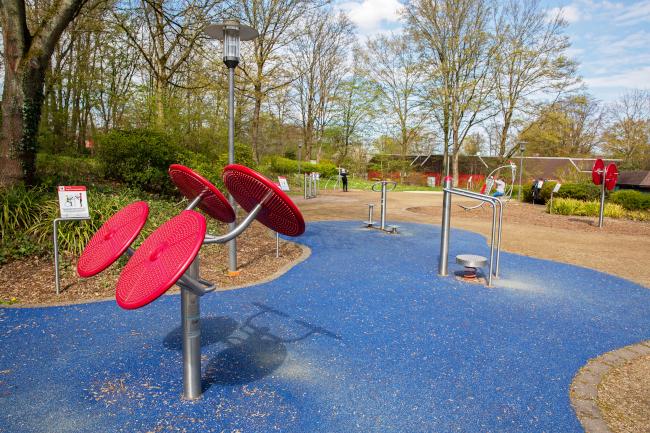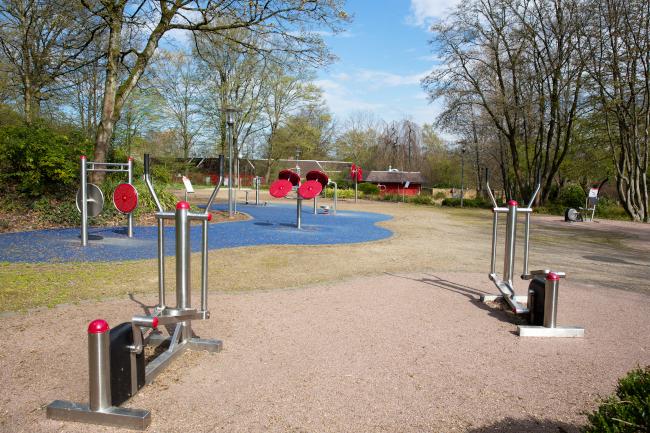published in sb magazine 5/2021
The Grugapark in Essen is a great example of a sustainably planned and equipped outdoor gym. The success of such installations depends on selecting the right location, having an appropriate combination of exercise stations and the quality and safety of the equipment used.
The keep fit movement of the 1970s can be regarded as the forerunner of today‘s fitness boom and the outdoor gym. Trim trails were circular routes three or four kilometres in length along which 15 to 20 exercise stations were installed. The movement wasn‘t targeted at competitive sports, but an affluent society afflicted by obesity and cardiovascular disease.
During the 1990s, new trend sports emerged. Jogging in particular enjoyed a boom in popularity. The keep fit movement, and fitness trails especially, faded into oblivion. Many local authorities simply didn‘t have the money to pay for their long-term upkeep.
Since the revival of the keep fit movement in Germany, which began in 2008, it‘s common nowadays for a variety of styles of outdoor gym to be installed instead of individual pieces of apparatus.

photo: Martin Michalak Fotografie
Outdoor gym

photo: Martin Michalak Fotografie
This is a recreational facility that updates elements of a trim trail and combines them with features of a playground. Such facilities consist of several complementary installations in public spaces. They serve to supplement the recreational activities in parks and green spaces.
There are basically three factors that determine the success of facilities like these: the embedding in the environment, choosing apparatus appropriate for the anticipated user groups, and the quality of the installed equipment. The attractiveness of the surroundings (park) and its accessibility play an important role here too. It often makes sense, for example, to tailor the gym specifically to the needs and activities of older people.
Apparatus that is designed like industrial machinery tends to put people off. A simple, elegant design is much more likely to encourage people to use it. Design considerations are naturally associated with quality and sustainability too.
Grugapark Essen

photo: Martin Michalak Fotografie
The Park was created on the occasion of the first major Ruhrland horticultural show in 1929. In 2012, the City of Essen developed the “Grugapark 2020 Development Concept“ in order to create modern exercise opportunities for young and old – in the open air and in a secure environment.
The result was a very attractive circular trail that connects twelve exercise stations with one another. The fitness trail can be used by people of all ages to test and improve their vitality and motor skills in a fun and enjoyable manner.
The biggest outdoor gym was supplied by playfit®. It consists of 17 pieces of apparatus making it the largest and most varied gym within the park. All parts of the body can be trained here in a goal-oriented or casual way – in the form of balance, strength and endurance training. Some pieces of equipment, like the wheelchair trainer, the duplex shoulder trainer and the arm bike are also designed to be used by wheelchair users, thus promoting the principle of inclusion.
Several stations offer massaging and fascia training functions for the purpose of relieving tension. These are popular with people with tight backs and tired legs. Instructions on how to use the stations are posted on signs. All equipment meets DIN EN 16630:20 and is TÜV/GS certified.
Successful concept

photo: Martin Michalak Fotografie
The site-specific response with innovative prefabricated construction systems were key design generators. Insulated tilt-up concrete walls in combination with CLT panels reduced the construction time by several months. This carbon sequestering construction avoided 1,380 metric tons of CO₂ while improving occupant health and well-being. Multiple strategies were employed to conserve energy, water and natural resources with the overall energy use 30 % less than a comparable project type. This included a 95.9 KW (DC) photovoltaic system with a bifacial photovoltaic canopy on the community room that generates energy and offers shade and rain protection.





